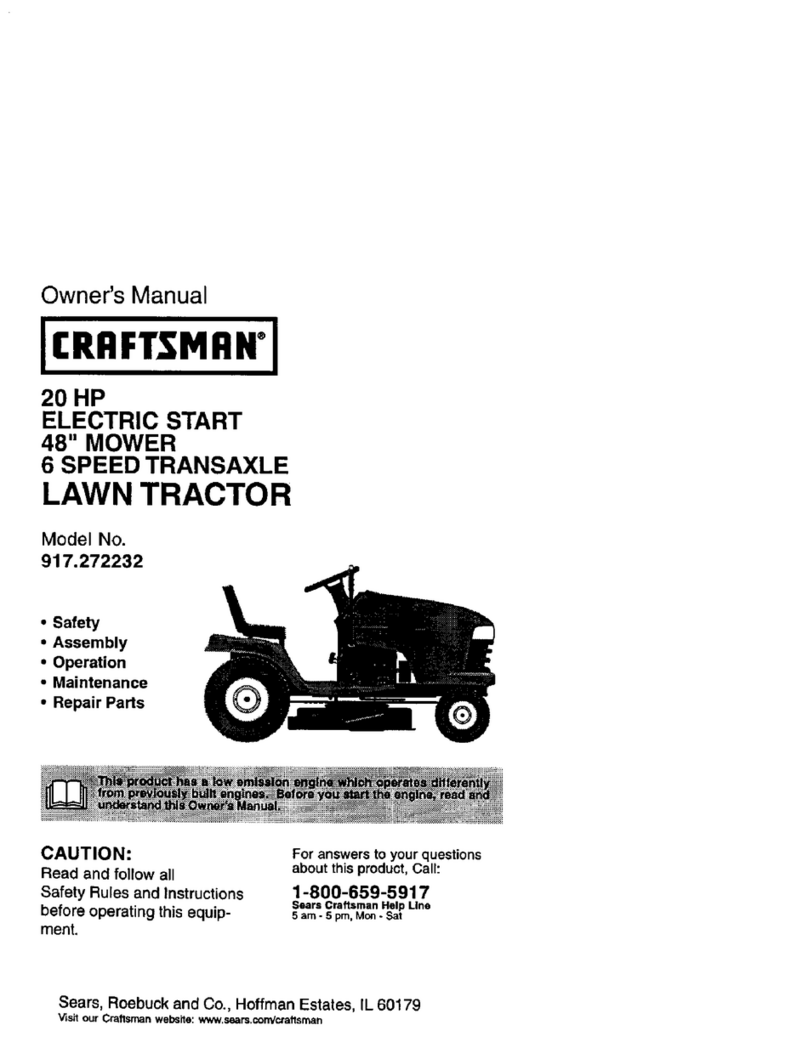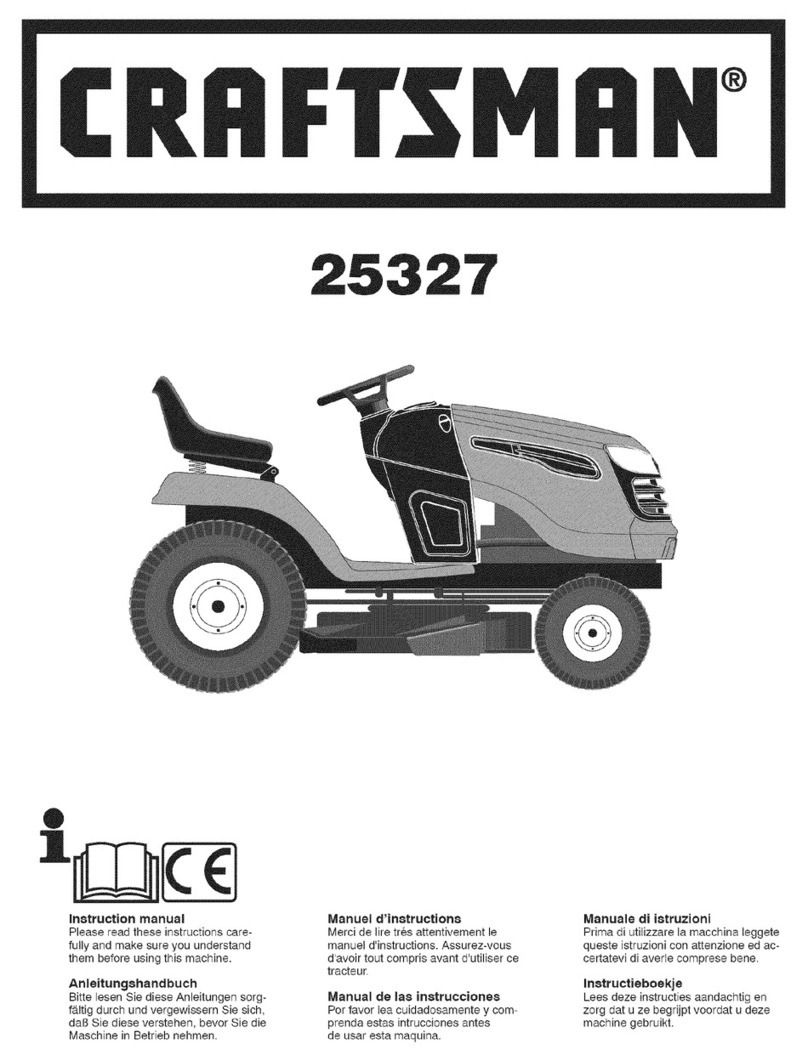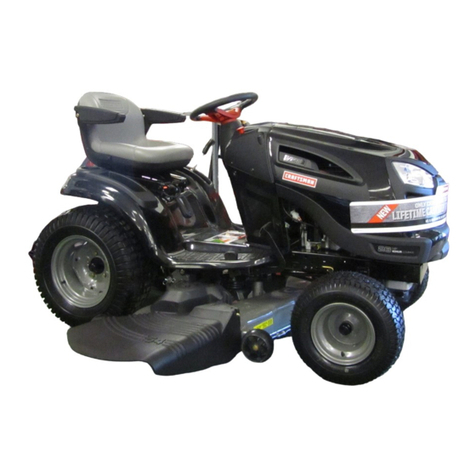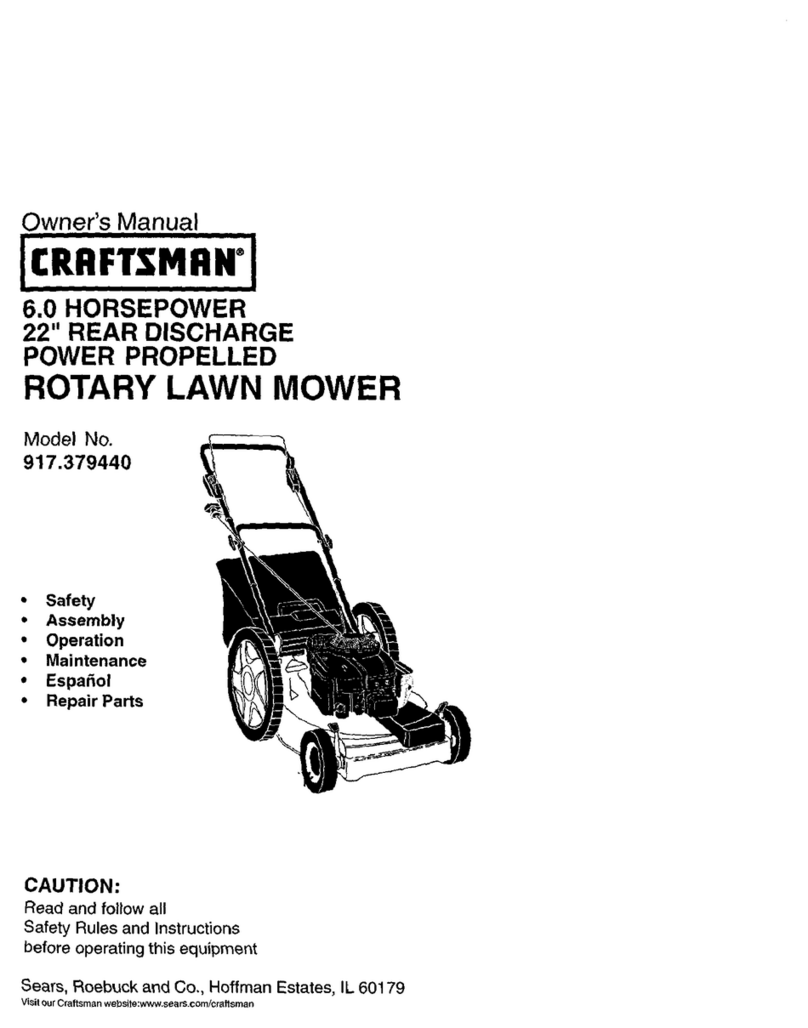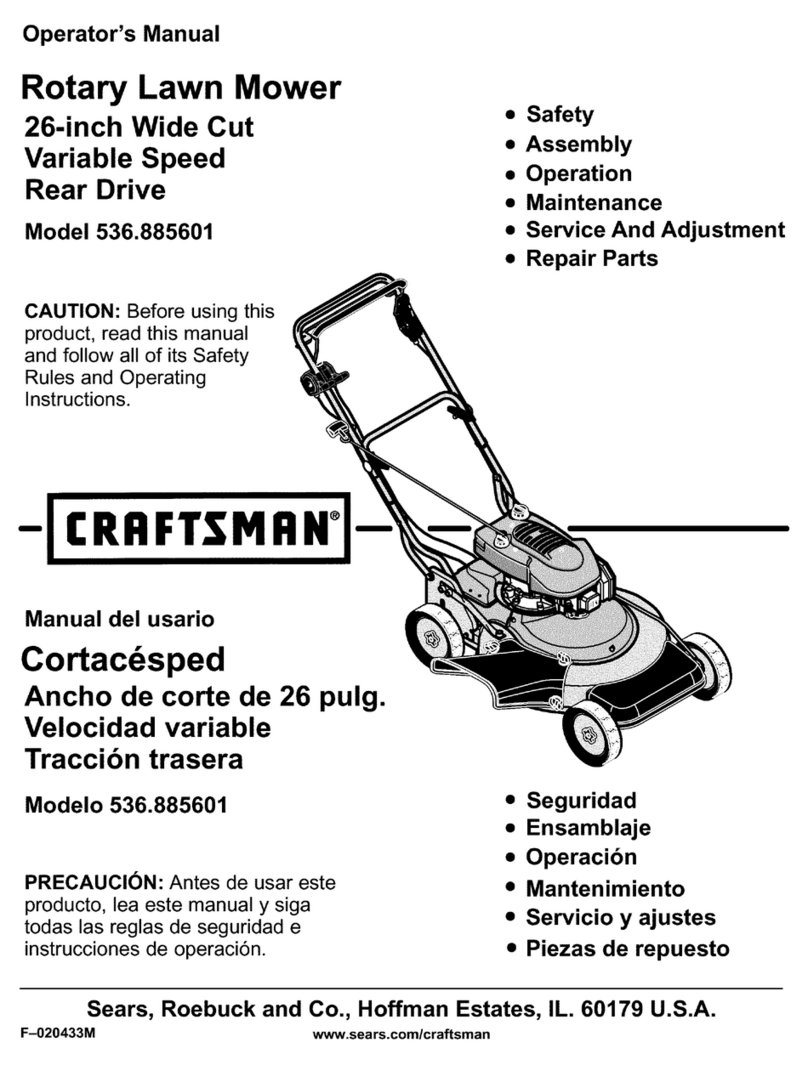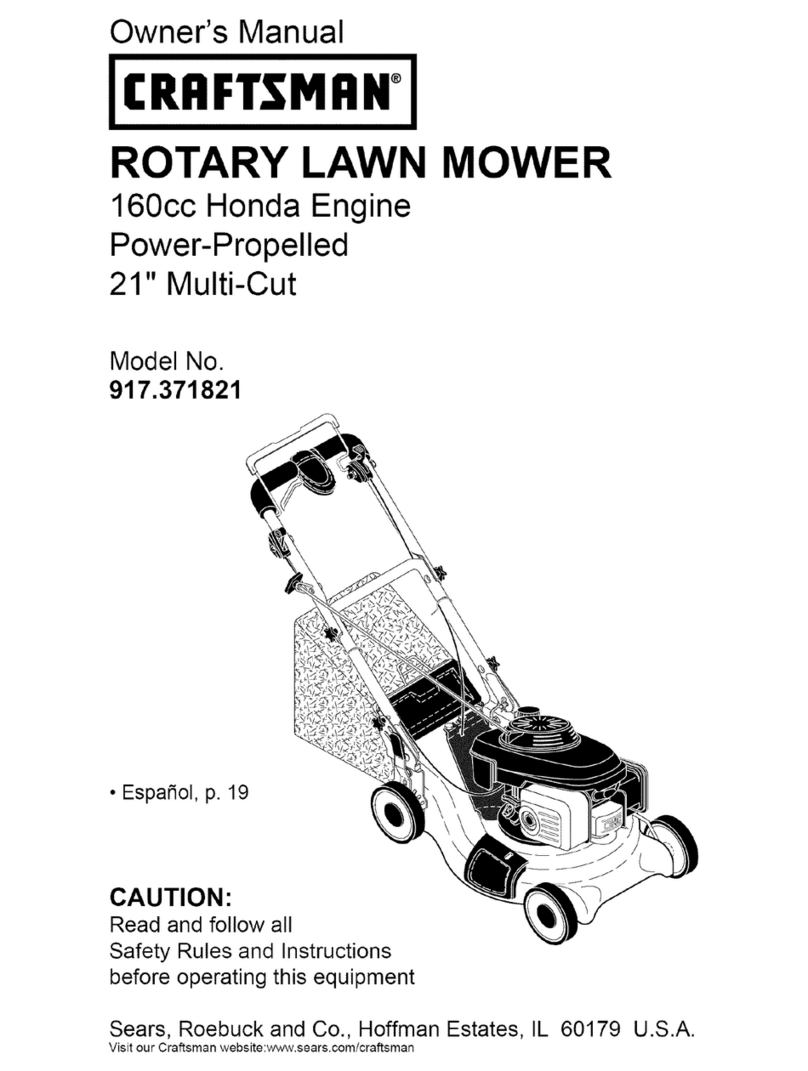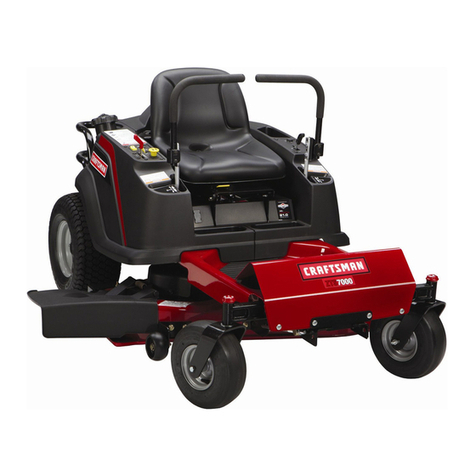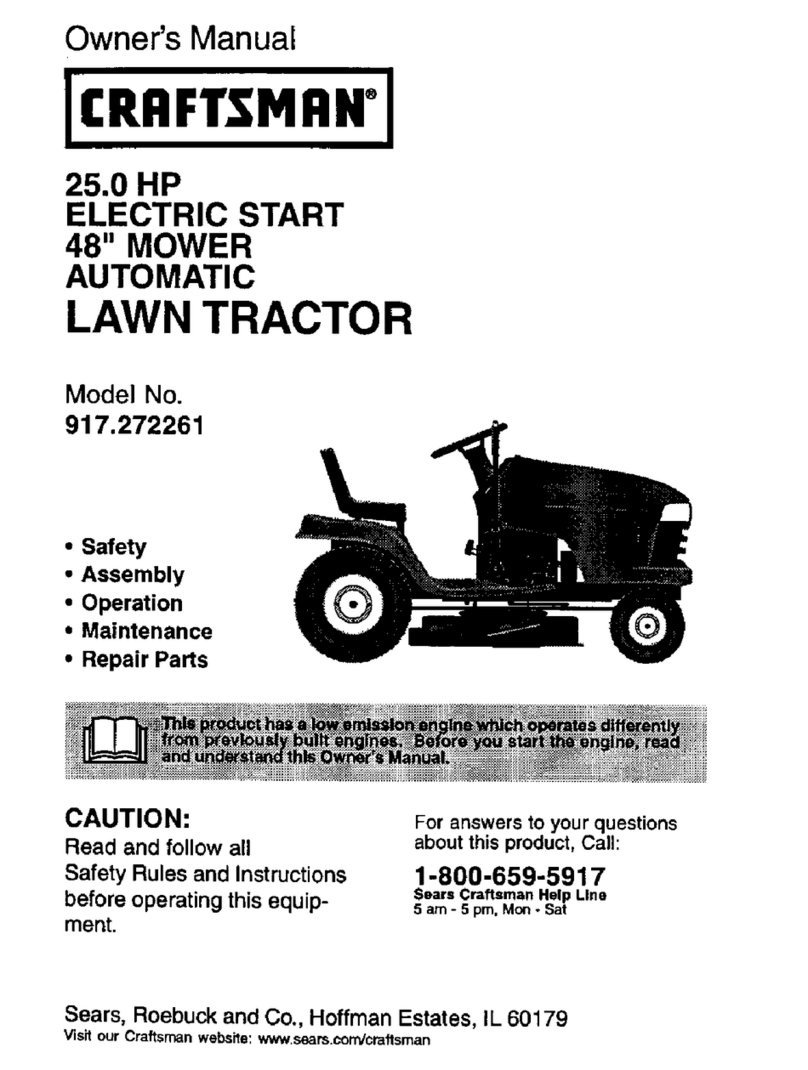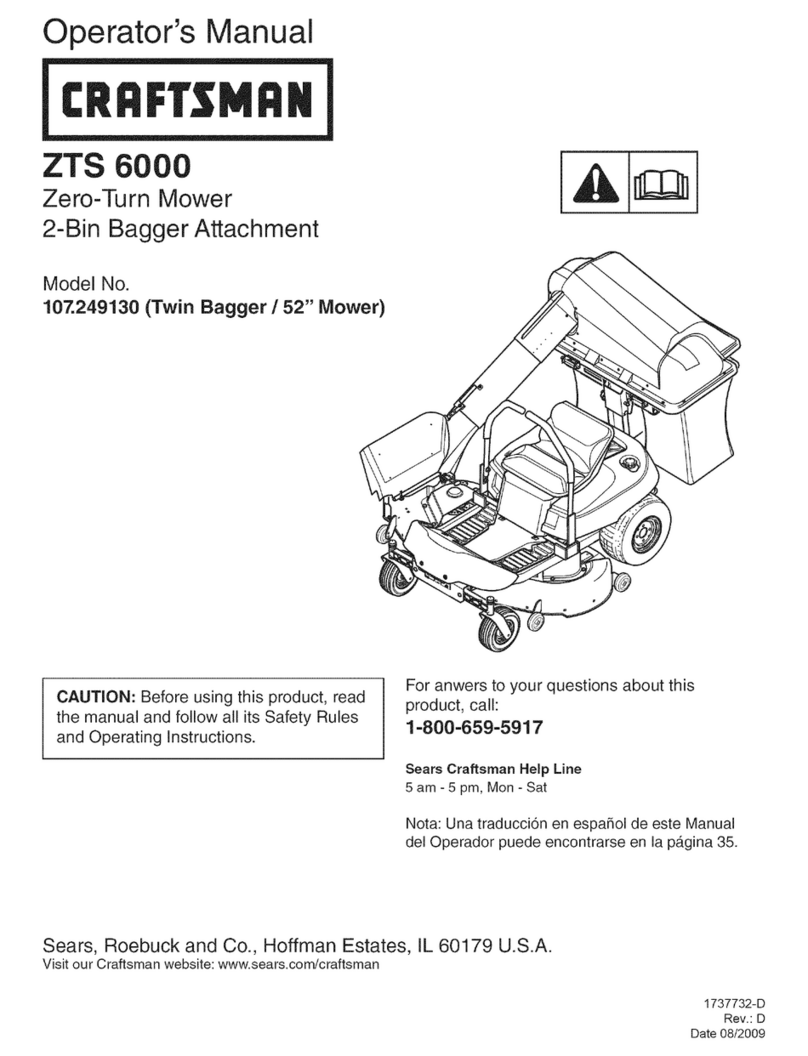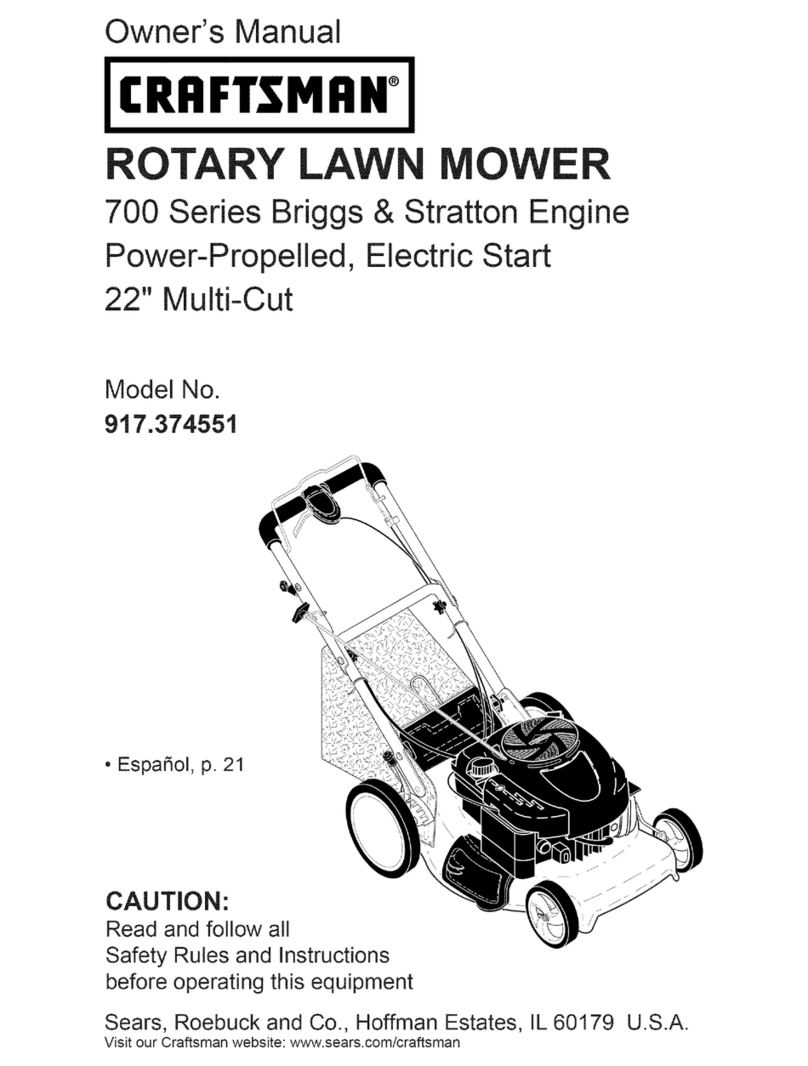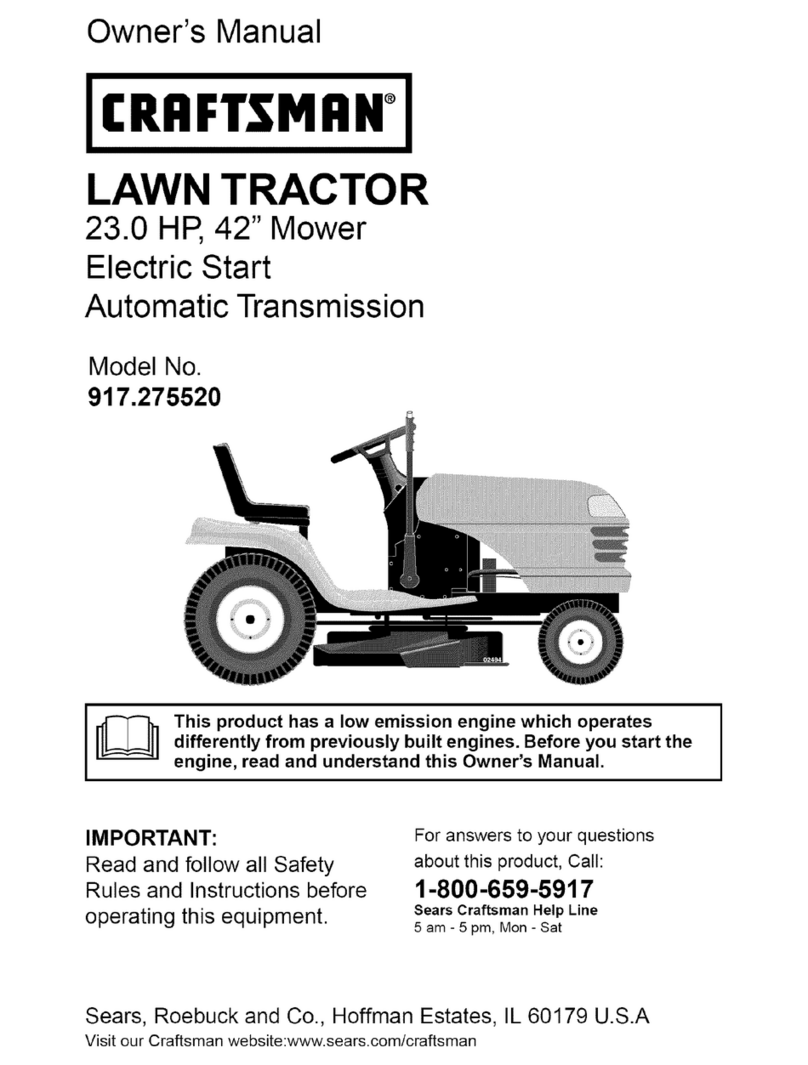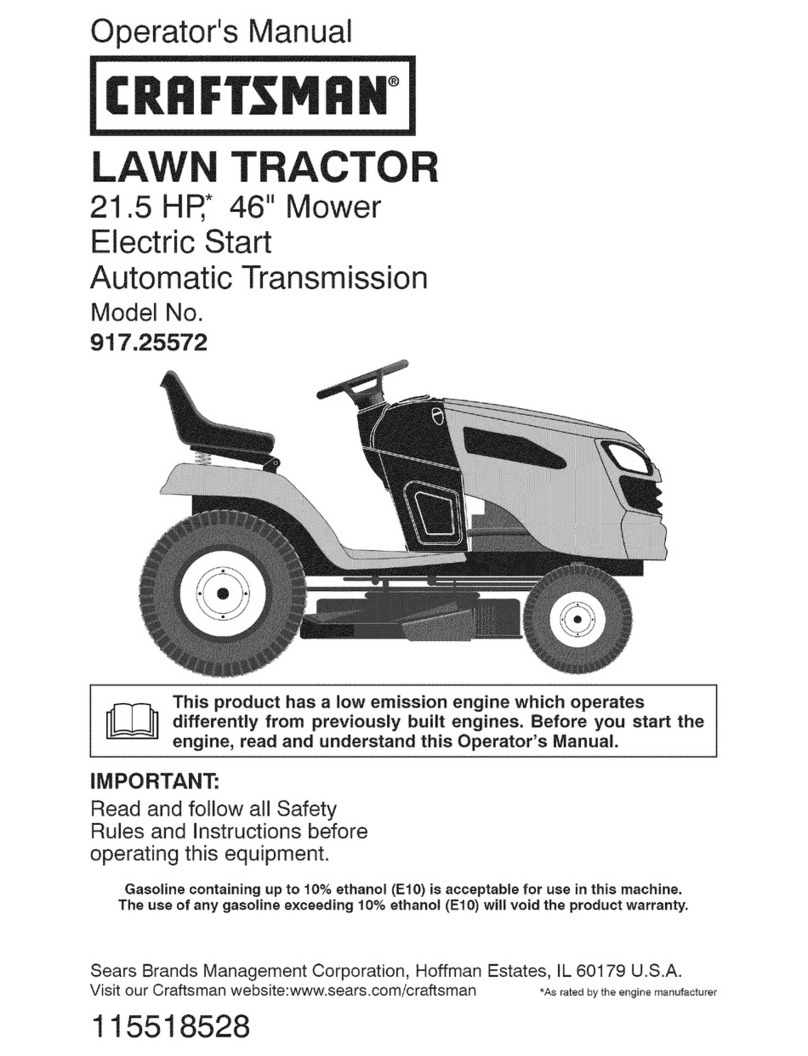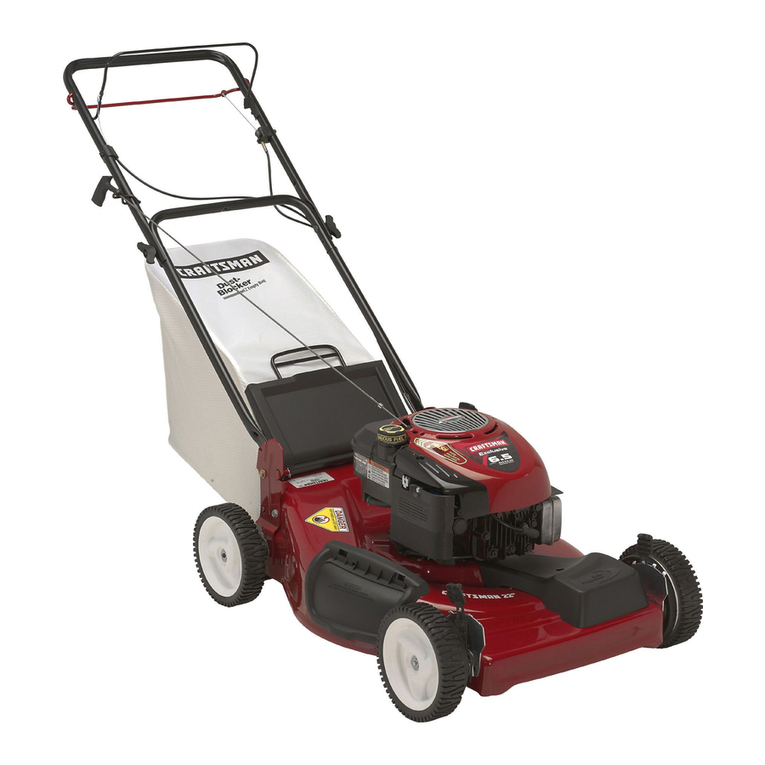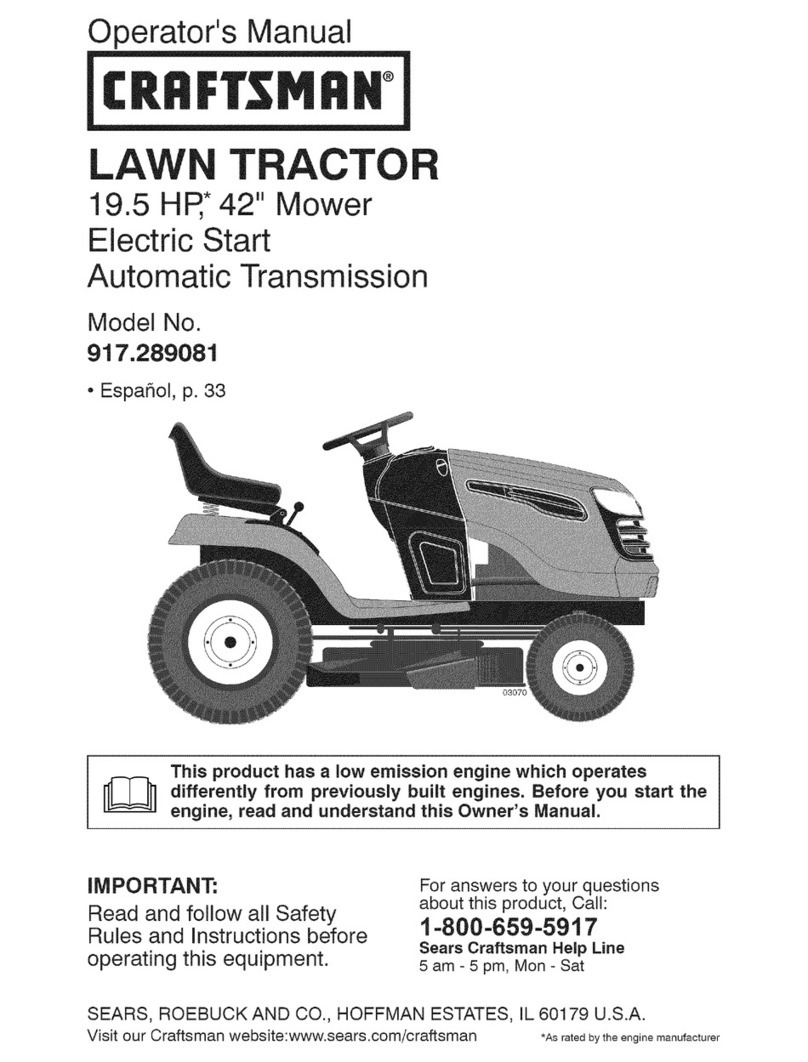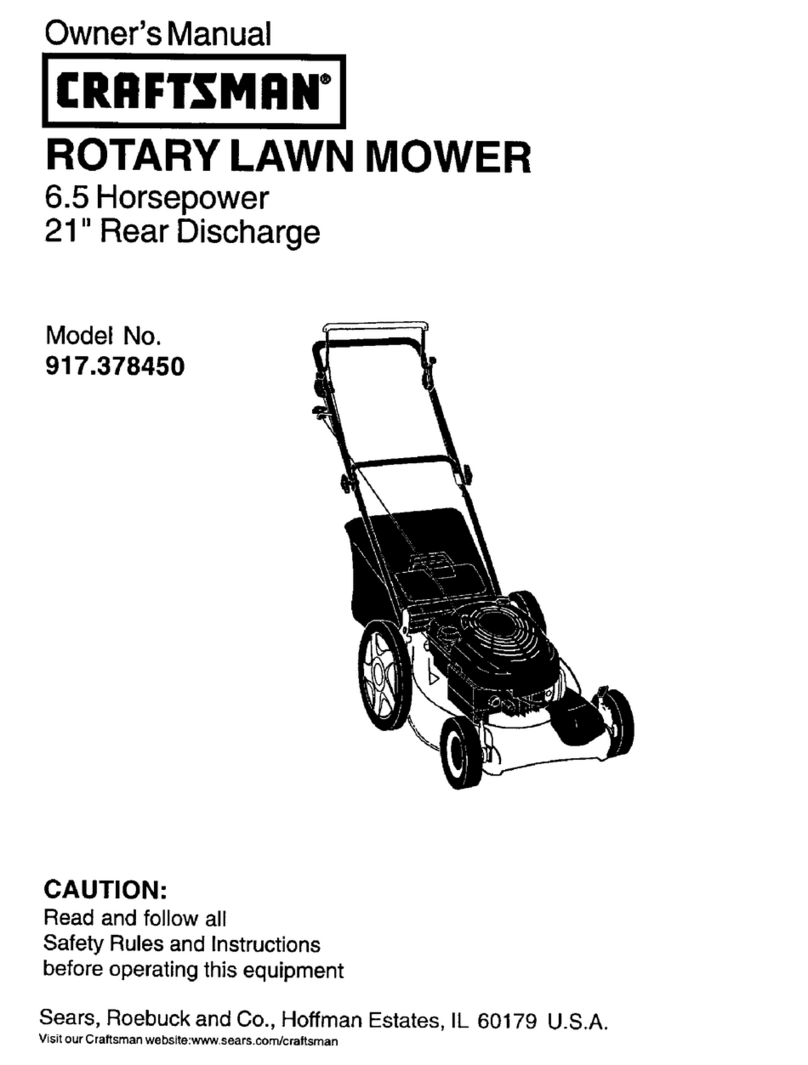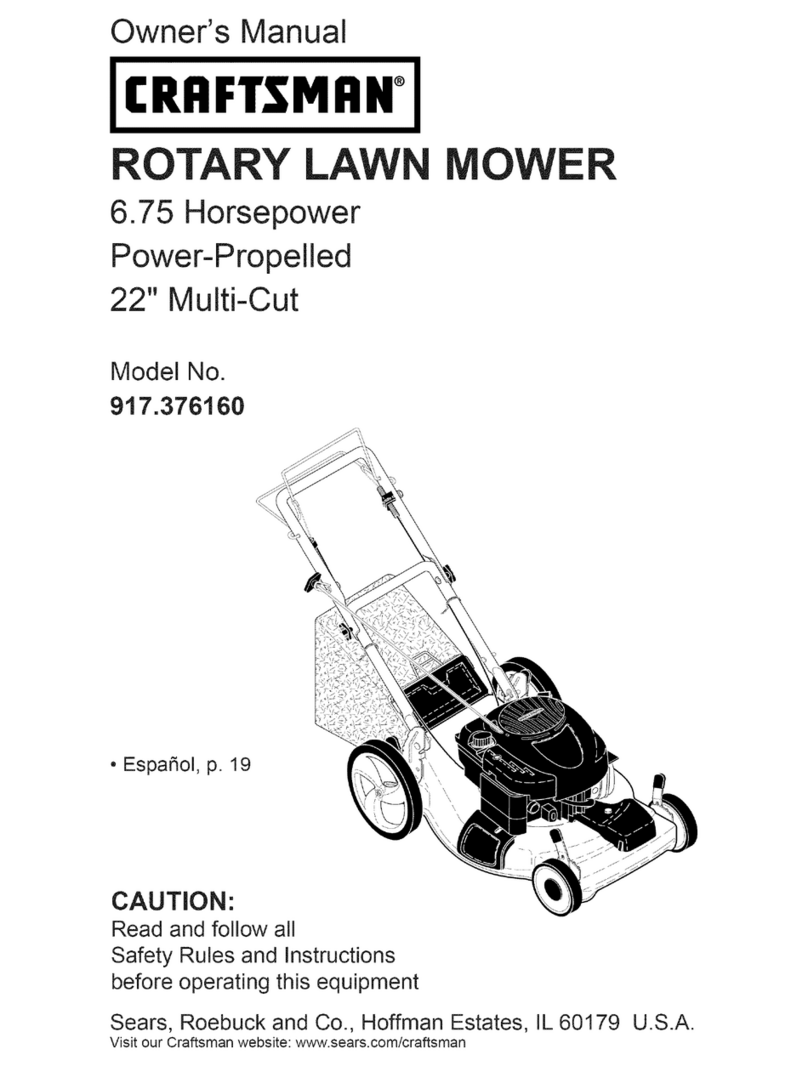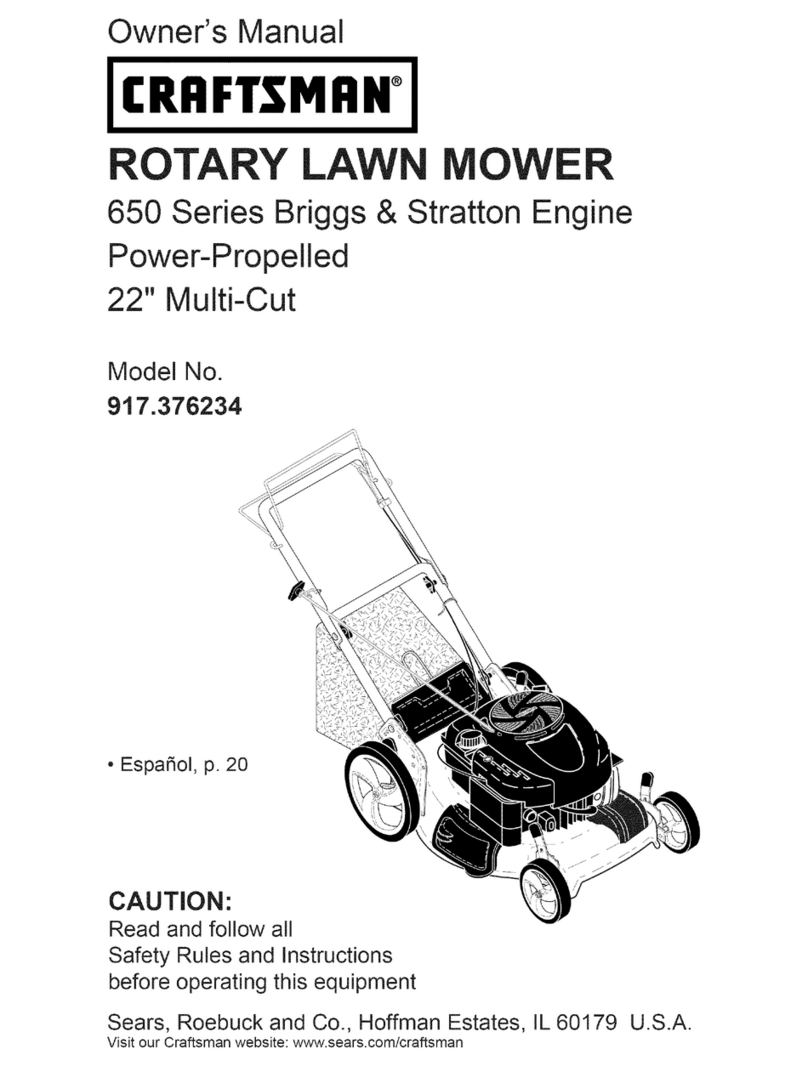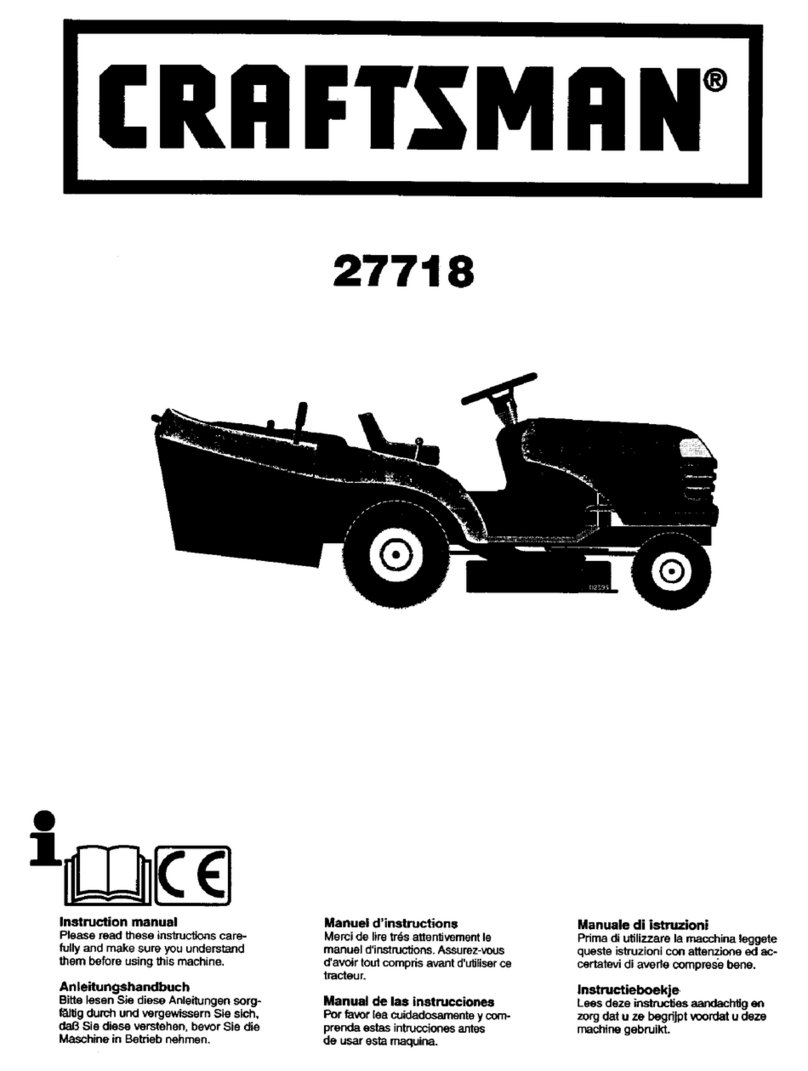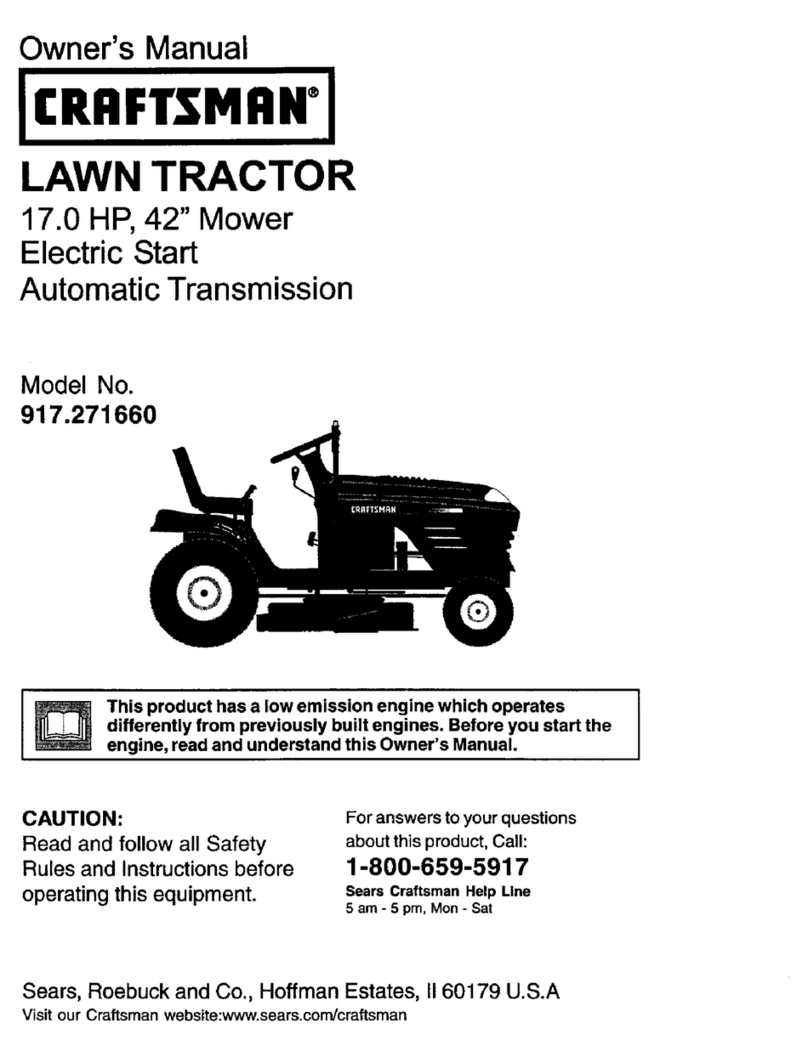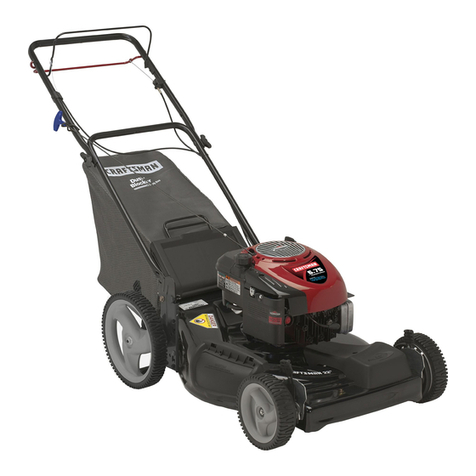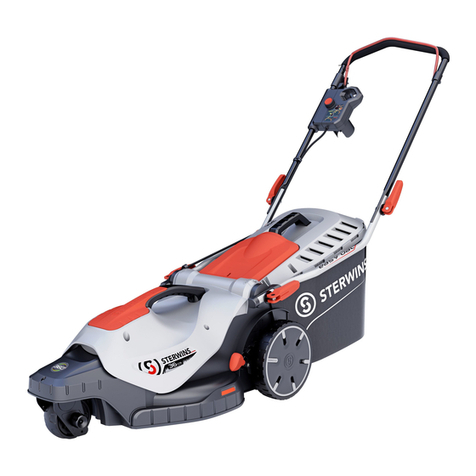6
CUSTOMER RESPONSIBILITIES
• Read and observe the safety rules.
• Follow a regular schedule in maintaining,
caring for and using your tractor.
• Follow instructions under “Maintenance”
and “Storage” sections of this manual.
• Wear proper Personal Protective Equip-
ment(PPE)whileoperatingthismachine,
including(at aminimum) sturdyfootwear,
eye protection, and hearing protection.
Do not mow in shorts and/or open toed
footwear.
• Alwaysletsomeoneknowyouareoutside
mowing.
WARNING: Thistractorisequippedwith
an internal combustion engine and should
not be used on or near any unimproved
forest-covered, brush-covered or grass-
covered land unless the engine’s exhaust
system is equipped with a spark arrester
meeting applicable local or state laws (if
any). If a spark arrester is used, it should
be maintained in effective working order by
the operator.
CONGRATULATIONS onyourpurchaseof
a new tractor. It has been designed, engi-
neeredandmanufacturedtogiveyouthebest
possible dependability and performance.
Shouldyouexperienceanyproblemyoucan-
noteasilyremedy,pleasecontactaSearsor
otherqualifiedservicecenter. Wehavecom-
petent,well-trainedrepresentatives andthe
proper tools to service or repair this tractor.
Please read and retain this manual. The
instructions will enable you to assemble
and maintain your tractor properly. Always
observe the “SAFETY RULES”.
InthestateofCaliforniatheaboveisrequired
bylaw(Section4442oftheCaliforniaPublic
Resources Code). Other states may have
similar laws. Federal laws apply on federal
lands. A spark arrester for the muffler is
availablethroughyournearestSearsservice
center (See REPAIR PARTS manual).
REPAIR PROTECTION AGREEMENTS
Congratulations on making a smart pur-
chase. Your new Craftsman® product is
designed and manufactured for years of
dependableoperation.Butlikeallproducts,
itmayrequirerepairfromtimetotime.That’s
whenhavingaRepairProtectionAgreement
can save you money and aggravation.
Purchase a Repair Protection Agreement
now and protect yourself from unexpected
hassle and expense.
Here’s what’s included in the Agreement:
• Expertservicebyour12,000professional
repair specialists.
• Unlimitedserviceandnochargeforparts
and labor on all covered repairs.
• Product replacement if your covered
product can’t be fixed.
• Discount of 10% from regular price of
service and service-related parts not
coveredbytheagreement;also,10%off
regularpriceof preventivemaintenance
check.
• Fast help by phone – phone support
fromaSearsrepresentativeonproducts
requiringin-homerepair,plusconvenient
repair scheduling.
OnceyoupurchasetheAgreement,asimple
phonecallisallthatittakesforyoutosched-
uleservice.Youcancallanytimedayornight,
or schedule a service appointment online.
Sears has over 12,000 professional repair
specialists, who have access to over 4.5
millionqualityparts andaccessories.That’s
thekindofprofessionalismyoucancounton
tohelpprolongthelifeofyournewpurchase
for years to come. Purchase your Repair
Protection Agreement today!
Some limitations and exclusions apply.
Forpricesandadditionalinformationcall
1-800-827-6655.
SEARS INSTALLATION SERVICE
For Sears professional installation of home
appliances, garage door openers, water
heaters,and othermajorhomeitems,inthe
U.S.A. call 1-800-4-MY-HOME®
PRODUCT SPECIFICATIONS
Gasoline Capacity
and type: 4.0 Gallons/15,14 L
Regular Unleaded
Oil Type:
(API: SG-SL) SAE30 (above 32°F/0°C)
SAE 5W30 (below 32°F/0°C)
Oil Capacity: 64 Oz./1,96 L
Spark Plug: Champion RC12YC
(Gap: .030"/0.76 mm)
Ground Speed
(Mph/Kph): Forward: 0 - 7.8/12,5
Reverse: 0 - 2.9/4,7
Charging
System: 15 amps @ 3600 rpm
Battery: Amp/Hr: 28
Min. CCA: 230
Case size: U1R
Blade Bolt Torque: 45-55 Ft. Lbs./62-75 Nm
67
IDENTIFICACIÓN DE PROBLEMAS:
Veala sección apropiada enel manuala menosque estédirigidoaun centro de servicio Sears.
PROBLEMA CAUSA CORRECCIÓN
No arranca 1. Sin combustible. 1. Llene el estanque de combustible.
2. Motor sin la “ESTRANGULACIÓN”
(CHOKE) adecuada. 2. Vea “PARA HACER ARRANCAR EL MO-
TOR” en la sección de operación.
3. Motor ahogado. 3. Espere varios minutos antes detratar de
arrancar.
4. Bujía mala. 4. Cambie la bujía.
5. Filtro de aire sucio. 5. Limpie/cambie el filtro de aire.
6. Filtro de combustible sucio. 6. Cambie el filtro de combustible.
7. Agua en el combustible. 7. Vaciar el estanque de combustible y el
carburador, vuelva a llenar el estanque
con gasolina nueva cambie el filtro de
combustible.
8. Alambrado suelto o dañado. 8. Revise todo el alambrado.
9. Carburador desajustado. 9.
Vea “PARA AJUSTAR
EL CARBURADOR”
en la sección de Servicio y Ajustes.
10. Válvulas del motor desajustadas. 10. Pongase en contacto con un centro de
servicio cualificado "SEARS".
Difícil de
arrancar 1. Filtro de aire sucio. 1. Limpie/cambie el filtro de aire.
2. Bujía mala. 2. Cambie la bujía.
3. Batería baja o descargada. 3.
Vuelva a cargar o cambie la batería.
4. Filtro de combustible sucio. 4. Cambie el filtro de combustible.
5. Combustible rancio o sucio. 5. Vaciarelestanquedecombustibleyvuelva
a llenarlo con gasolina nueva.
6. Alambrado suelto o dañado. 6. Revise todo el alambrado.
7. Carburador desajustado. 7. Vea“PARAAJUSTARELCARBURADOR”
en la sección de Servicio y
Ajustes.
8.
Válvulas del
motor desajustadas. 8. Pongase en contacto con un centro de
servicio cualificado "SEARS".
El motor no
la vuelta 1. Pedal del freno no presionado. 1. Presione el pedal del freno.
2. Elembraguedelaccesorioestáenganchado. 2. Desengancheelembraguedel accesorio.
3. Batería baja o descargada. 3.
Vuelva a cargar o cambie la batería.
4. Fusible quemado. 4. Cambie el fusible.
5.
Terminales de la batería corroídos.
5. Limpie los terminales de la batería.
6. Alambrado suelto o dañado. 6. Revise todo el alambrado.
7. Interruptor de la ignición fallado. 7. Revise/cambieelinterruptordelaignición.
8. Solenoide o arrancador fallados. 8. Revise/cambie el solenoide o arrancador.
9. Interruptor(es) que exige(n) la presencia
del operador fallado. 9. Pongase en contacto con un centro de
servicio cualificado "SEARS".
El motor
suena pero
no arranca
1. Batería baja o descargada 1.
Vuelva a cargar o cambie la bate
ría.
2.
Terminales de la batería corroídos.
2.
Limpie los terminales de la batería.
3. Alambrado suelto o dañado. 3. Revise todo el alambrado.
4. Solenoide o arrancador fallados. 4. Revise/cambie el solenoide o arrancador.
Pérdida de
fuerza 1.
Corta mucho césped, muy rápido.
1. Elevelaalturadecorte/reduzcalavelocidád
2. Aceleración en la posición de
“ESTRAN-
GULACIÓN” (CHOKE).
2. Ajuste el control de la aceleración.
3. Acumulación de césped, hojas y basura
debajo de la segadora. 3. Limpie la parte inferior de la cajade la
segadora.
4. Filtro de aire sucio. 4. Limpie/cambie el filtro de aire.
5. Nivel de aceite bajo/aceite sucio. 5. Reviseelniveldeaceite/cambieel aceite.
6. Bujía fallada. 6. Limpie y vuelva a ajustar la abertura o
cambie la bujía.
7. Filtro de combustible sucio. 7. Cambie el filtro de combustible.
8. Combustible rancio o sucio. 8. Vaciarelestanquedecombustibleyvuelva
a llenarlo con gasolina nueva.
